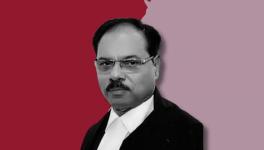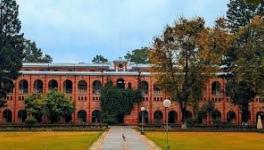The Real News That Noise About Ayodhya Drowned Out
The noise was all around us. The news was buried, if at all. For days, most of India’s media were tripping over themselves to bring us the preparation. When 5 August dawned, there was no stopping them. Their excitement over the Ram temple in Ayodhya, where the Babri mosque had stood till the evening of 6 December 1992, paralleled that of the organisation which had orchestrated the deeply-divisive Ramjanmabhoomi movement. To mark the day, anchors were fitted out in saffron lest the message was lost on the masses.
For Prime Minister Narendra Modi, whose love for spectacle is legendary, this was the grandest parade of them all. From the moment he touched down at the airport, fitted out in shimmering saffron, the media torpedoed him at viewers as if he were a hero. He strode as if savouring victory on a battlefield—and battlefield it was given that thousands of lives were lost during the Ramjanmabhoomi movement and communal riots. Without betraying any sense of irony, he presided monarch-like over the event, as if he owned the movement. He later told a select audience that an allegedly “centuries-old desire” of Hindus was being fulfilled. “This day is a unique gift from the law-abiding India to truth, non-violence, faith and sacrifice,” he claimed unblinkingly. Every word stood for its opposite.
The Hindu Rashtra project:
The ahistorical and dangerous parallel between India’s struggle for Independence and the Ramjanmabhoomi movement that his party’s parent organisation Rashtriya Swayamsevak Sangh (RSS) spearheaded was deliberate. He was seeking respect for the blood-stained movement by recasting it in the framework of the pluralistic movement for India's freedom. The bhoomipujan, in his allusion, was throwing off the yoke of the secular and democratic republic—Nehruvian India, as it were—just as the freedom movement had thrown off the yoke of the British empire.
Indians whose primary identity now is that of aggressive Hindu, who have tied their nationalism to the Hindutva agenda, who revel in making those unlike them second-class citizens found satisfaction in the 5 August event. For Modi and his political machine, it was yet another elaborate spectacle in a rather long list of them which fill up the moment, generate excitement and drama, but offer little to improve the lives of millions of Indians in a tangible way.
Those few hours of 5 August, with relentless visuals, Modi’s speech, and RSS chief Mohan Bhagwat’s words, mark a cleaving of post-Independence India—the old one that sought to be secular and multi-cultural, the new one that does not even pretend to honour the opening words of the Constitution.
For Modi, Bhagwat and their followers, Hindu Rashtra became a reality that day unmindful of what India’s 170-180 million Muslims and millions of Hindus who frown at the temple project, should make of it. A section of the Congress party’s leaders chipped in with Lord Ram’s sterling qualities, abandoning India’s secularism in the political sphere. Only the CPI(M)’s Sitaram Yechury issued a statement that pointed to constitutional issues.
Bhagwat or Hindutva patriarch LK Advani presiding over the bhoomipujan would have meant a fitting end to the 30-year-old cynical Ram Janmabhoomi movement. As India’s Prime Minister took his aasan, he fused the RSS agenda with that of the Government of India. On Friday, Uttar Pradesh Chief Minister Yogi Adityanath cemented it by refusing to attend any ceremony for the mosque rebuilding on grounds that he is “a Hindu”. Indeed, India moved eons away from the time former prime minister Jawaharlal Nehru refused to grace the Somnath temple programme in his official capacity.
Through this, the media was unmistakably in high-decibel cheerleading mode. The morning papers, with a few honourable exceptions, poetically lauded the event—striking a witless contrast to 1992 when most had represented the Babri mosque’s demolition as a “shame”. Television anchors were beside themselves with unbridled joy. One channel invited Swapan Dasgupta, once an editor and now a BJP member and Rajya Sabha MP, to offer detailed “intellectual” justification for the Ram Janmabhoomi movement and the 5 August event. Another channel had an anchor exulting about Ram dhun sung in schools and invited a BJP spokesperson to sing a Ram bhajan. Figuratively, India had turned its back on the lines “Ishwar Allah Tero Naam, Sabko Sanmati De Bhagwan” in Gandhi’s favourite “Raghupati Raghav Rajaram”.
What news did this noise drown out?
Plenty, it appears. One, in those uninterrupted live broadcasts, breathless panel discussions, newspaper headlines and most online clickbait-ish banners, there was stony silence or barely a whisper about the sullied site of the “grand” temple or the blood that was spilt in the communal riots that the temple movement sparked off in the early 1990s. The bhoomipujan was at the site of sacrilege and illegality, which even the Supreme Court of India acknowledged when it called the demolition a “barbaric” and “criminal act”. The highly-problematic aspects of that judgement found no mention in the mainstream press. The movement and rath yatra that left a bloody trail across India found no mention either.
Of course, there was no recall of the head priest who was found murdered months after the demolition, ostensibly for his opposition to the rath yatra and politicisation of the Ram temple, or that the men and women who helmed the demolition had yet to stand trial in the criminal case. There was convenient collective amnesia of these aspects among those who did stories about the reign of the first Mughal, Babar, which ended nearly 500 years ago. All of this and more was erased from the popular narrative.
Two, 5 August marked the completion of one year of reading down Article 370 of the Constitution, of peremptorily bifurcating Jammu & Kashmir into two Union Territories, placing it under an unprecedented blockade and turning it into a symbol of the unmasked majoritarianism of Modi Sarkar 2.0. The saturation coverage from Ayodhya meant that Kashmir’s tryst with Modi 2.0 got little space. It was, for Modi and the “Modified” media, last year’s triumph. The government wanted no spotlight on the plight of people or the mess there; most media obliged.
Three, the Galwan Valley face-off with China all but vanished from news. The breathless build-up to the bhoomipujan and live telecasts with over-the-top commentary meant that serious issues about India’s territorial integrity and foreign policy hardly got news space. A document detailing the face-off was uploaded and then taken down from the Ministry of Defence website. It’s safe to say, in UPA times this would have been a scandal and the media would have kept at it without respite.
Four, Covid-19 stories too were pushed out of news space. Leading up to 5 August, India’s count in the global tally was the highest ever with more than 52,000 cases—a quarter of all cases in the world that day. India now has more than 2 million cases and counting, more than 41,000 deaths and counting, in a war against the virus that Modi had declared would be finished in a few short weeks. That an elaborate religious event was organised with state resources in the middle of a pandemic did not outrage the media.
Five, millions of migrant workers who were all over the headlines and news spaces after the Indian government and media suddenly discovered them in the last week of March barely got a mention. Their wellbeing, their work and wages, their tryst with the pandemic lay forgotten.
Six, the economy continues to sputter without a clear direction for revival, the Rs. 20 lakh crore stimulus package yet to make any impact, pre-pandemic unemployment figures that were the worst in 45 years turning poorer with unprecedented economic contractions and lay-offs, rising fuel and food prices denting household incomes by the day. News about the economy and heated discussions about the Modi government’s listless response should have dominated news space. However, the Ayodhya event was brought centre-stage with drama, spectacle and Modi.
As the “festivities” concluded in Ayodhya, the country’s financial and commercial capital was struck by a raging storm that brought record rain and flooding to South Mumbai. There was widespread damage; the signage atop the Bombay Stock Exchange was battered and tumbled. Fittingly figurative, as it were.
The ceremony at Ayodhya was a RSS event. Modi transformed it into a Government of India spectacle without so much as a blush. The media made Modi celebrity of the day and the Ram temple almost an emblem of the country. Noise masked news all the way.
The author is a senior journalist and columnist who writes on politics, cities, media and gender. The views are personal.
Get the latest reports & analysis with people's perspective on Protests, movements & deep analytical videos, discussions of the current affairs in your Telegram app. Subscribe to NewsClick's Telegram channel & get Real-Time updates on stories, as they get published on our website.























